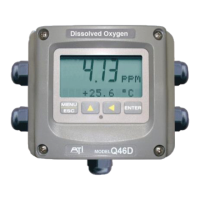4
O&M Manual
Rev-N (4/21)
Part 1 - Introduction
1.1 General
The Model Q46D is a versatile on-line monitoring system designed for the continuous
measurement of dissolved oxygen in solution. The full scale operating range of the system 0-40
ppm, and the sensing system will operate on water streams with temperatures ranging from 0 to
50C.
The basic sensing element used in the dissolved oxygen monitor is a galvanic membrane sensor
which measures oxygen directly.
Q46/60 Monitors are available in two electronic versions, an AC powered monitor with integral
alarm relays and dual 4-20 mA output capability, and a 12-24 VDC unit with dual output and
relays. Options are available to add either a third 4-20 mA output or 3 additional low power SPST
relays. In addition, a digital output option for Profibus, Modbus, or Ethernet is available.
1.2 Standard System
The standard model Q46D/60 system includes two components, the Q46D analyzer and a
dissolved oxygen sensor. For connection of the sensor to the electronics, a 25' cable is supplied.
Up to an additional 1000 feet of interconnect cable may be added using #07-0100 junction box.
All required spare parts are also provided with the basic system, including spare membranes,
electrolyte, o-rings, and any special hardware.
1.3 Features
• Standard Q46D electronic transmitters are designed to be a fully isolated instruments for
operation from either 90-260 VAC or 12-24 VDC power supplies.
• High accuracy, high sensitivity system, measures from 0.1 ppm to 40.0 ppm through 2 internal
automatic ranges.
• Two 4-20 mA analog outputs are standard, and a third analog output is available as an option.
One output may be configured for PID control, while other outputs are programmable to track
either D.O. or Temperature.
• Selectable PID controller on main analog output. PID includes manual operation feature, and
diagnostic “stuck-controller” timer feature for relay notification of control problems.
• Digital communication option for Profibus-DP, Modbus-RTU. More versions pending. See Q46
Digital Communications Manual for Specifications.
• Output Hold, Output Simulate, Output Alarm, and Output Delay Functions. All forced changes in
output condition include bumpless transfer to provide gradual return to on-line signal levels and to
avoid system control shocks on both analog outputs.

